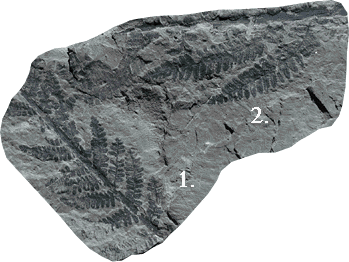Pecopteris miltoni
 |
Rock Type: Gray shale
Formation: Allegheny
Interval: 5-Block seam
Age: Middle Pennsylvanian Period, approx. 303 million years.
Pecopteris is the form genus name assigned to the seed fern Psaronius,
an extinct tree-like plant known to achieve heights of 50 feet or more with
a base of 5 feet or more in diameter. It had a thin skin, at least near
it's base, but the multiple layers of adventitious roots which enveloped
it likely gave it additional strength.
1. View a close-up image.
2. View a close-up image. |
|
This form genus/species pecopteris miltoni is characterized
by having multiple-lobed pinnules (individual leaves) near the base of the
larger leaflets. The pinnules near the end of the leaflet are seldom divided.
Select close-up 2. above to view these features. Only the larger
leaflets show the lobe divisions, however, so the smaller leaflets technically
belong to another form species, even though they are attached to the same
stem, . Crazy, isn't it?
Eventually the lobed pinnules would grow until they matured to a new
leaflet cluster, whose pinnules would in turn progress through the same
developmental stages of first straight, then lobed pinnules, on their way
to themselves becoming new leaflets.
Location: Lincoln County, West Virginia; Copley Trace Surface Mine #2,
located about 10 miles west of Atenville, West Virginia. Take Route 68 west
for 3 miles, turn left on Route 68 / 1 (Francis Creek Road) and drive approximately
6 miles. Veer left up Kiah Creek, continue approx. 1.5 miles to Copley Trace.
Take next right, proceed up ridge past Meeks Cemetary. Truck access only.


